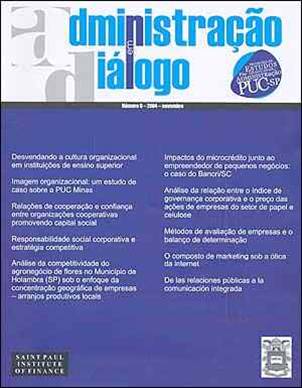Responsabilidade social corporativa e estratégia competitiva
DOI:
https://doi.org/10.20946/rad.v6i1.677Abstract
Neste artigo buscamos traçar a relação entre responsabilidade social corporativa, vantagem competitiva e imagem corporativa. Nosso objetivo é demonstrar que a responsabilidade social das empresas, quando seriamente praticada, gera vantagem competitiva através da diferenciação da corporação e da identificação de valores comuns com os consumidores. Os modelos de diferenciação tradicionais não são suficientes para explicar novos paradigmas como a responsabilidade social e devem ser ampliados, já que ela também pode ser um importante instrumento para se alcançar vantagem competitiva. Assim, além das vantagens que a responsabilidade social gera para seu público-alvo, as empresas também obtém diversos benefícios com estas ações. Palavras-chave: Responsabilidade social, vantagem competitiva, imagem corporativa. Abstract In this article we attempt to trace the relation among corporate social responsibility, competitive advantage and corporate image. Our aim is to show that corporate social responsibility, when seriously performed, generates competitive advantage thru company differentiation and thru the identification of common values with consumers. The traditional differentiation models are not enough to explain new paradigms like the corporate social responsibility and they should be extended, as corporate social responsibility can be an important tool to achieve competitive advantage. Thus, further than the advantages that social responsibility generates to it’s target audience, the companies also obtain several benefits with these practices. Keywords: Social responsibility, competitive advantage, corporate image.Metrics
Downloads
Published
How to Cite
Issue
Section
License
Authors who publish in this journal agree to the following terms:
1. Authors retain the copyright and grant the journal the right of first publication, with the work licensed simultaneously under a Creative Commons Attribution License after publication, allowing the sharing of work with acknowledgment of the authorship of the work and initial publication in this journal.
2. Authors are authorized to take additional contracts separately, for non-exclusive distribution of the version of the work published in this journal (eg publish in institutional repository or as a book chapter), with acknowledgment of authorship and initial publication in this journal.
3. Authors are allowed and encouraged to publish and distribute their work online (eg in institutional repositories or on their personal page) at any point before or during the editorial process, as this can generate productive changes, as well as increase the and the citation of the published work (See The Effect of Free Access).









